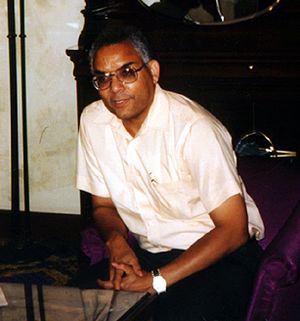Raymond L. Johnson facts for kids
Quick facts for kids
Raymond Lewis Johnson
|
|
|---|---|

Raymond L. Johnson in 1995
|
|
| Born | 25 June 1943 Alice, Texas, US
|
| Alma mater | |
| Known for |
|
| Scientific career | |
| Fields |
|
| Institutions | |
| Notable students | Kimberly Sellers |
Raymond Lewis Johnson (born in 1943) is a famous American mathematician. He is now a retired professor at the University of Maryland, College Park and also teaches at Rice University.
Dr. Johnson made history as the first African-American student at Rice University. He was also the first African-American mathematics professor at the University of Maryland. His work often focused on complex math problems and a field called harmonic analysis.
Contents
Growing Up and School
Early Life in Texas
Raymond Johnson was born on June 25, 1943, in a town called Alice, Texas. He went to a small school that was only for Black children. Each of its two rooms had kids from four different grades!
Raymond's grandfather taught him to read and do math at home. Because of this, Raymond was able to skip two grades in school.
A Big Change in Schools
In 1954, a very important decision was made called Brown v. Board of Education. This decision said that schools could no longer be separated by race. After this, Raymond was allowed to go to the formerly all-white high schools in Alice. He started in ninth grade.
A few years later, in 1957, the Soviet Union launched Sputnik, the first satellite into space. This started the "Space Race" and made schools focus more on science and math. Raymond took part in these special programs.
College and Mentors
Raymond earned a special scholarship called the National Merit Scholarship. He used it to go to the University of Texas at Austin. He chose to study math because he enjoyed it a lot in high school.
His high school math teacher, Larry O'Rear, and a college professor named Howard B. Curtis helped him a lot. Professor Curtis became a mentor, guiding Raymond through much of his math learning. Another important person at the University of Texas was Vivienne Malone-Mayes, an African-American math student who helped grade Raymond's classes.
Breaking Barriers at Rice University
After college, Professor Curtis suggested Raymond go to Rice University for graduate school. Rice University's original rules said only white people from Texas could attend. But the university decided to change these rules.
Raymond Johnson was accepted to Rice in 1963. This made him the first African-American student ever admitted to Rice University! However, his start was delayed until 1964 because some former students sued the university to stop this change.
Raymond worked at Rice for a year before becoming a regular student. He almost left when he found out he was being paid less than other students. But he got a special fellowship and decided to stay.
At Rice, Raymond met his future wife, Claudette. They both took part in protests during the Civil Rights Movement. Raymond finished his advanced math degree in 1969.
A Career in Mathematics
Teaching and Mentoring
After finishing his studies, Raymond Johnson got a job at the University of Maryland, College Park. He became the first African-American mathematics professor there.
At Maryland, Dr. Johnson worked hard to help and encourage African-American students. He especially helped students from historically black colleges and universities. He was a mentor to 23 students who went on to earn their doctoral degrees. Many of these students were African-American, and many were women. One administrator at the university said that the math department's success in helping minority students was "based on the leadership of Ray Johnson."
He taught at the University of Maryland for 40 years. For two years, from 1976 to 1978, he also taught at Howard University. In 2007, he returned to Rice University.
Awards and Special Recognition
Honoring His Work
Raymond Johnson has received many awards for his important work.
- In 1986, the University of Maryland gave him their Distinguished Minority Faculty Award.
- In 2006, he received the Mentor Award for Lifetime Achievement from the American Association for the Advancement of Science. This award recognized his long history of helping others.
- In 2015, he won the Presidential Award for Excellence in Science, Mathematics and Engineering Mentoring. This is a very special award given by the White House to only a few scholars each year.
- In 2017, he was recognized by Mathematically Gifted & Black as an honoree for Black History Month.
- In 2022, Raymond Johnson was named a Fellow of the American Mathematical Society. This honor was given for his important contributions to math and for his efforts to help more African Americans join the field of mathematics.

